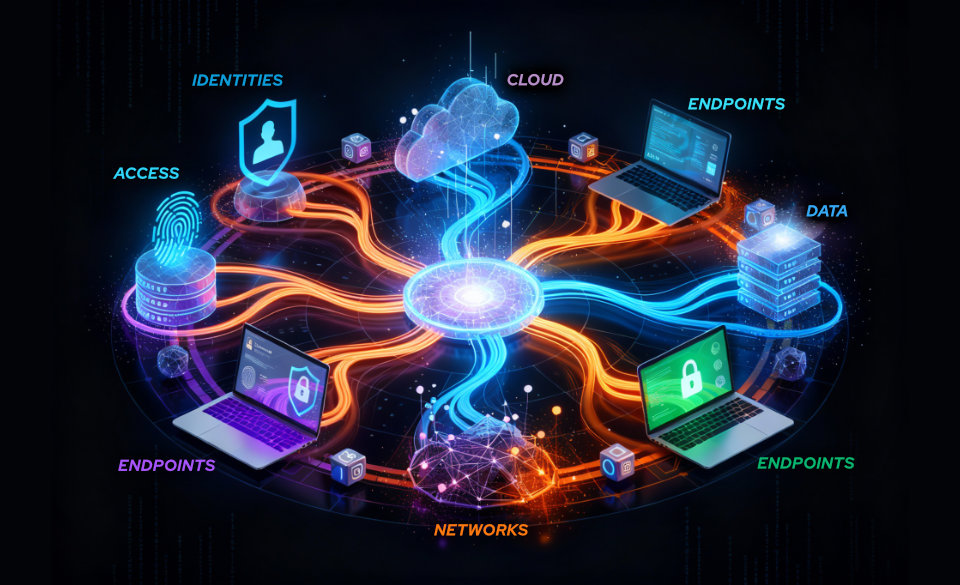
Cognitive technology and quantum computing: the convergence that will transform the world
4 de September de 2025
Data Exfiltration: understanding the threat and how to prevent it
25 de September de 2025The term DDoS comes from Distributed Denial of Service. Its main goal is to disrupt the availability of a service, application, server, or network, preventing legitimate users from accessing it. This is done by overwhelming the victim’s resources with a traffic volume that exceeds its capacity to respond, causing extreme slowness, connection errors, or even complete service outage.
Unlike a traditional DoS attack, which is carried out from a single machine, a DDoS coordinates multiple devices from different points around the world, making it more difficult to detect, trace, and neutralize.
This type of attack is especially dangerous in critical infrastructures such as banks, telecommunications operators, energy systems, or e-commerce platforms, where constant availability is essential.
1. How a DDoS Works
To understand how a DDoS attack is executed, it is useful to view it as a structured process in phases, where each step prepares the ground for the next.
Phase 1: Reconnaissance
Before launching an attack, the cybercriminal carries out an in-depth analysis of the target, called reconnaissance.
The goal is to identify vulnerabilities and critical points, since a successful attack depends on overwhelming specific resources that are difficult for the system to scale or absorb.
Common techniques in this phase include:
- Port scanning: using tools like Nmap, the attacker identifies active services (HTTP, FTP, SSH, DNS) that could be saturated or exploited.
- Application and server fingerprinting: detects software versions that may have known vulnerabilities or low capacity limits.
- Network topology mapping: discovers routers, firewalls, and key servers, allowing attackers to plan where to focus the attack for maximum impact.
- Protocol and service enumeration: identifies vulnerable protocols such as ICMP, TCP, or UDP, and open services that can amplify the attack.
Phase 2: Botnet creation
To launch an effective DDoS, the attacker needs a network of controlled devices, known as a botnet.
These devices may include:
- Unprotected servers and computers: systems with outdated software or missing security patches.
- Poorly configured routers and network equipment: especially those with default credentials or known vulnerabilities.
- IoT devices: security cameras, printers, industrial sensors, or household appliances connected to the internet.
Centralized control of the botnet is carried out through a command-and-control (C2) server, which sends instructions to each device to synchronize the attack. This enables the generation of enormous, coordinated traffic spikes that would be impossible to replicate from a single machine.
Phase 3: Attack execution
Once the botnet is ready, the attack is launched. Depending on the target, it may focus on different infrastructure layers:
- Volumetric: saturates the victim’s bandwidth, measured in gigabits or terabits per second.
- Protocol-based: exploits weaknesses in communication protocols, collapsing buffers, connection tables, or network resources.
- Application-layer: simulates legitimate traffic to the application, such as HTTP or API requests, which are difficult to distinguish from real users.
Important: Each type of attack requires different strategies and defenses. A deep understanding of these differences is essential for security professionals.
2. Types of DDoS Attacks
2.1 Volumetric Attacks
These aim to saturate the network’s transmission capacity, preventing legitimate traffic from reaching its destination.
Examples:
- UDP Flood: massive sending of UDP packets to random ports. Each packet consumes bandwidth and system resources.
- DNS Amplification: the attacker sends DNS requests with the victim’s IP, generating responses much larger than the original query.
- NTP Amplification: similar to DNS Amplification, but uses NTP servers to amplify traffic toward the target.
Key point: The victim receives more traffic than it can process, leading to network saturation and service outage.
2.2 Protocol Attacks
These exploit weaknesses in communication protocols to exhaust system resources, without requiring large traffic volumes.
Examples:
- SYN Flood: sends incomplete TCP connection requests, consuming the server’s connection tables.
- Ping of Death: sends fragmented ICMP packets that exceed the allowed size, crashing older systems.
- Smurf Attack: uses ICMP broadcast traffic to amplify the response toward the victim.
Key point: These attacks are more sophisticated, as they do not require massive traffic, but instead exploit protocol logic.
2.3 Application Layer Attacks
These directly target the application or service logic, generating requests that appear legitimate. They are the most difficult to detect and mitigate.
Examples:
- HTTP GET/POST Floods: sends thousands of requests to web pages or forms.
- Attacks on REST or GraphQL APIs: overload critical endpoints.
- Login or massive download attacks: block essential authentication or data transfer services.
3. Historical Examples of DDoS
- GitHub (2018): 1.35 Tbps attack via misconfigured memcached servers.
- Dyn (2016): IoT Mirai botnet causing global outages.
- Estonia (2007): coordinated attacks paralyzing government and banking systems.
Lesson learned: These cases show that even critical and well-protected infrastructures can be vulnerable without advanced mitigation strategies.
4. Risks of a DDoS
- Loss of availability: critical services may become inaccessible for minutes or hours.
- Economic impact: transaction disruption, breached contracts, revenue loss, and regulatory fines.
- Reputation damage: customer and partner trust can be severely affected.
- Security compromise: some attacks act as a smokescreen to introduce malware or steal data while the security team is busy mitigating the DDoS.
Note: A DDoS not only affects availability but can also open the door to much more serious attacks if not detected and mitigated in time.
5. Mitigation strategies
5.1 Layered defensive architecture
- Redundancy and Anycast: distribute services across multiple data centers to avoid single points of failure.
- CDNs and Scrubbing Centers: filter and absorb malicious traffic before it reaches the final server.
- Load balancers and intelligent firewalls: detect anomalous patterns and dynamically block malicious IPs.
5.2 Advanced technologies
- Rate Limiting and Adaptive Throttling: control the request rate per user or IP, adjusting automatically.
- Deep Packet Inspection (DPI): analyzes each data packet to identify malicious traffic at the application level.
- SOAR and SIEM: automate incident response, correlate events, and accelerate mitigation.
5.3 Protection with Endurance
Certified as PAM, Endurance adds several critical defensive layers for essential infrastructures:
- Privileged access segmentation: restricts internal user scope, preventing attackers from reaching critical systems.
- Encrypted Connection Broker: transmits only keyboard, mouse, video, and audio events, avoiding resource saturation.
- Remote session isolation: ensures administrative sessions remain inviolable even during a DDoS.
6. Future perspective
DDoS attacks are evolving with:
- Larger, more sophisticated botnets.
- AI-driven adaptive attacks.
- Malicious use of cloud infrastructure.
Conclusion: Cyber defense must be predictive, resilient, and automated, combining scalable architecture, threat intelligence, and advanced mitigation tools.
7. Conclusion
UUnderstanding DDoS is essential for any security professional. Prevention requires:
- Advanced technology capable of absorbing and filtering malicious traffic.
- Threat intelligence and continuous attack pattern analysis.
- Resilient architectures that ensure operational continuity even under extreme pressure.
Only a comprehensive approach makes it possible to protect critical services, guarantee availability, and maintain customer and partner trust in an increasingly hostile digital environment.




